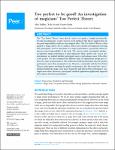Too perfect to be good? An investigation of magicians’ Too Perfect Theory
| dc.contributor.author | Pailhès, A | |
| dc.contributor.author | Lee, K | |
| dc.contributor.author | Kuhn, G | |
| dc.date.accessioned | 2023-11-23T12:49:30Z | |
| dc.date.available | 2023-11-23T12:49:30Z | |
| dc.date.issued | 2022-05-30 | |
| dc.identifier.issn | 2167-8359 | |
| dc.identifier.issn | 2167-8359 | |
| dc.identifier.other | e13449 | |
| dc.identifier.uri | https://pearl.plymouth.ac.uk/handle/10026.1/21684 | |
| dc.description.abstract |
The “Too Perfect Theory” states that if a trick is too perfect, it might paradoxically become less impressive, or give away its secret method. This theory suggests that an increased impossibility results in a less magical effect. The Too Perfect Theory is often applied to magic effects, but it conflicts with recent scientific investigations showing that participants’ level of enjoyment of a magic performance is positively related to their perceived impossibility of the trick. The current article investigated whether an imperfect magic performance is more impressive than a perfect one. Across two experiments, we studied whether participants enjoy a performance more if the effect is not perfect. We also examined the different types of explanations people give to these two types of performances. The results showed that participants enjoyed a perfect performance more than an imperfect one. However, consistently with the Too Perfect Theory, participants watching the perfect performance also discovered the correct method behind the magic trick more frequently and believed the performance was staged more often. Moreover, participants’ method explanation significantly impacted their reports about the performance. | |
| dc.format.extent | e13449-e13449 | |
| dc.format.medium | Electronic-eCollection | |
| dc.language | en | |
| dc.publisher | PeerJ | |
| dc.subject | Alternative solution | |
| dc.subject | Explanation | |
| dc.subject | Magic tricks | |
| dc.subject | Problem-solving | |
| dc.subject | Too-perfect theory | |
| dc.subject | Humans | |
| dc.subject | Magic | |
| dc.subject | Pleasure | |
| dc.title | Too perfect to be good? An investigation of magicians’ Too Perfect Theory | |
| dc.type | journal-article | |
| dc.type | Journal Article | |
| plymouth.author-url | https://www.ncbi.nlm.nih.gov/pubmed/35663521 | |
| plymouth.volume | 10 | |
| plymouth.publisher-url | http://dx.doi.org/10.7717/peerj.13449 | |
| plymouth.publication-status | Published online | |
| plymouth.journal | PeerJ | |
| dc.identifier.doi | 10.7717/peerj.13449 | |
| plymouth.organisational-group | |Plymouth | |
| plymouth.organisational-group | |Plymouth|Faculty of Health | |
| plymouth.organisational-group | |Plymouth|Faculty of Health|School of Psychology | |
| plymouth.organisational-group | |Plymouth|Users by role | |
| plymouth.organisational-group | |Plymouth|Users by role|Academics | |
| dc.publisher.place | United States | |
| dcterms.dateAccepted | 2022-04-26 | |
| dc.date.updated | 2023-11-23T12:49:30Z | |
| dc.rights.embargodate | 2023-11-24 | |
| dc.identifier.eissn | 2167-8359 | |
| rioxxterms.versionofrecord | 10.7717/peerj.13449 |


